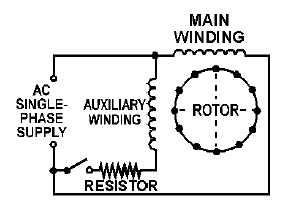4-14
Figure 4-12.—Resistance-start ac induction motor.
Q12.
How do split-phase induction motors become self-starting?
Shaded-Pole Induction Motors
The shaded-pole induction motor is another single-phase motor. It uses a unique method to start the
rotor turning. The effect of a moving magnetic field is produced by constructing the stator in a special
way. This motor has projecting pole pieces just like some dc motors. In addition, portions of the pole
piece surfaces are surrounded by a copper strap called a shading coil. A pole piece with the strap in place
is shown in figure 4-13. The strap causes the field to move back and forth across the face of the pole
piece. Note the numbered sequence and points on the magnetization curve in the figure. As the alternating
stator field starts increasing from zero (1), the lines of force expand across the face of the pole piece and
cut through the strap. A voltage is induced in the strap. The current that results generates a field that
opposes the cutting action (and decreases the strength) of the main field. This produces the following
actions: As the field increases from zero to a maximum at 90º , a large portion of the magnetic lines of
force are concentrated in the unshaded portion of the pole (1). At 90º the field reaches its maximum
value. Since the lines of force have stopped expanding, no emf is induced in the strap, and no opposing
magnetic field is generated. As a result, the main field is uniformly distributed across the pole (2). From
90º to 180º , the main field starts decreasing or collapsing inward. The field generated in the strap
opposes the collapsing field. The effect is to concentrate the lines of force in the shaded portion of the
pole face (3). You can see that from 0º to 180º , the main field has shifted across the pole face from the
unshaded to the shaded portion. From 180º to 360º , the main field goes through the same change as it did
from 0º to 180º ; however, it is now in the opposite direction (4). The direction of the field does not affect
the way the shaded pole works. The motion of the field is the same during the second half-cycle as it was
during the first half of the cycle.

